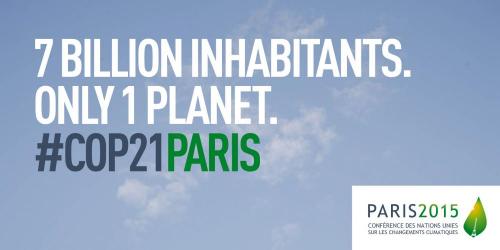
What is COP21?
The climate negotiations so far
The United Nations Framework Convention on Climate Change (UNFCCC) was adopted during the Rio de Janeiro Earth Summit in 1992. This Framework Convention is a universal convention of principle, acknowledging the existence of anthropogenic (human-induced) climate change and giving industrialized countries the major part of responsibility for combating it.
The adoption of the Kyoto Protocol at the Earth Summit in Rio de Janeiro, Brazil, in 1992 was a milestone in the international negotiations on tackling climate change.
For the first time, binding greenhouse gas emissions reduction targets were set for industrialised countries. The protocol, which entered into force in 2005, was intended to cover the period 2008-2012.
A longer-term vision was introduced by the Bali Action Plan in 2007, which set timelines for the negotiations towards reaching a successor agreement to the Kyoto Protocol, due to expire in 2012. It was expected that an agreement would be reached by December 2009.
Although Copenhagen , Denmark, did not result in the adoption of a new agreement, COP15/CMP5 recognised the common objective of keeping the increase in global temperature below 2°C. Furthermore, industrialised countries undertook to raise $100 billion per year by 2020 to assist developing countries in climate-change adaptation and mitigation. Cancún, Mexico, in 2010 made the 2°C target more tangible by establishing dedicated institutions on key points, such as the Green Climate Fund.
The willingness to act together was reflected in the establishment, in 2011, of the Durban Platform for Enhanced Action (ADP), whose mandate is to bring all countries, both developed and developing, to the table to develop “a protocol, another legal instrument or an agreed outcome with legal force” applicable to all the States Parties to the UNFCCC. This agreement should be adopted in 2015 and implemented from 2020.
In the interval until a legally binding multilateral agreement is implemented in 2020, the Doha Conference (Qatar) in 2012 established a second commitment period of the Kyoto Protocol (2013-2020), which was ratified by a number of industrialised countries, and terminated the Bali track.
The Climate Change Conferences in Warsaw , Poland, in 2013 and Lima , Peru, in 2014 enabled essential progress towards COP21 in Paris in 2015. All the States were invited to submit their Intended Nationally Determined Contributions (INDCs) towards reducing greenhouse gas emissions ahead of COP21.
One year of negotiations
In order to reach a new universal climate agreement that is applicable to all, the delegates of the 195 States Parties to the United Nations Framework Convention on Climate Change (UNFCCC) have held regular meetings to make progress on the text that will be voted on in Paris in December.
During the first session of negotiations, from 8 to 13 February in Geneva (Switzerland), they built on the work carried out during COP20 in Lima (Peru), from 1 to 14 December 2014. After a week of work, the delegates agreed on an 86-page text that would serve as a basis for the following four sessions. The last session was held from 19 to 23 October in Bonn (Germany), where the UNFCCC is based. The 1300 delegates finalized the text that will be discussed at COP21 (further information).
In parallel to the negotiation process, the French Minister of Foreign Affairs and International Development and future president of COP21, Laurent Fabius, held two rounds of informal ministerial consultations, in July and September (further information), in Paris. The aim of these work sessions was to reach compromises to enable the negotiations to move forward. Each of these meetings was attended by over fifty ministers.
This year of negotiations was marked by the publication on 7 October of the climate finance report by the OECD and the think tank Climate Policy Initiative. According to this report, $62 billion were raised in 2014 by developed countries to help developing countries cope with climate change (further information). This news showed that the commitment made by developed countries in Copenhagen in 2009 to raise $100 billion per year by 2020 (further information) is within reach.
In addition to the financial aspect, the other highlight was the publication of the UNFCCC synthesis report on national contributions on 30 October. Countries had until 1 October to publish their road maps on their greenhouse gas (GHG) emission reduction policies if they were to be included in the synthesis report. The UNFCCC studied the impact of 146 national contributions. As things stand, the global GHG emission pathway based on the published contributions would mean that by 2030 we would be heading for a rise of around 3°C, that is between 2.7°C and 3.5°C, by the end of the century. The worst-case scenario, with a rise of 4.5°C or even 6°C, which corresponds to current emission pathways and was until now considered the most probable scenario by scientists, is growing less likely. Thanks to these contributions, the target of 2°C by 2100 may be reached, provided we speed up the process (further information). One of the challenges of the Paris agreement will be to establish a periodic – ideally five-year – review mechanism to raise the ambition of each Party and progressively improve our collective pathway.
The last stage before COP21 was the pre-COP, from 8 to 10 November in Paris. More than 60 ministers from around the world answered Minister of Foreign Affairs and International Development Laurent Fabius’ invitation for the pre-COP, which was the largest, most productive one in the history of the UNFCCC. These three days of work helped achieve major progress ahead of Paris (further information).
Tags:
- 3125 reads










Add new comment